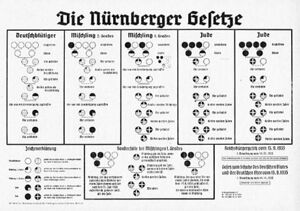Category:Mischlinge (subject)
Mischlinge ["mixed race"] (see Holocaust Children Studies)
Overview
"Mischlinge" was the legal term used in Nazi Germany to denote persons deemed to have both Aryan and Jewish ancestry.
Nazism believed that the Nordic Race/Culture constituted a superior branch of humanity, and viewed International Jewry as a parasitic and inferior race, determined to corrupt and exterminate both Nordic peoples and their culture through Rassenschande ("racial pollution") and cultural corruption.
As defined by the Nuremberg Laws in 1935, a Jew was a person – regardless of religious affiliation or self-identification – who had at least three grandparents who had been enrolled with a Jewish congregation. A person with two Jewish grandparents was also legally "Jewish" if that person met any of these conditions:
- Was enrolled as member of a Jewish congregation when the Nuremberg Laws were issued, or joined later.
- Was married to a Jew.
- Was the offspring from a marriage with a Jew, which was concluded after the ban on mixed marriages.
- Was the offspring of an extramarital affair with a Jew, born out of wedlock after 31 July 1936.
A person who did not belong to any of these categorical conditions but had two Jewish grandparents was classified as a Jewish Mischling of the first degree. A person with only one Jewish grandparent was classified as a Mischling of the second degree.
The majority of 1st- or 2nd-degree Mischlinge were (at least formally) "Christian" (57% Protestant, 41% Catholics), only 1% of them identified themselves as Jews. A considerable number of "Christian" Mischlinge, however, were such only by name and were de facto "non-religious".
Requests for reclassification (e.g., Jew to Mischling of 1st degree, Mischling of 1st degree to 2nd degree, etc. ) or Aryanization were personally reviewed by Adolf Hitler and were considered an act of grace. Reclassification could also be obtained by way of declaratory judgment in court, usually following (false) admission of adultery by (grand)mothers. The process gave way to bribery, extortion, abuses, and other subterfuges concerning documentation of who was, or was not, a Jew.
“Mischlinge” were “temporary citizens” of Germany, tolerated by the grace of the Nazi government. Yet they lived in a constant state of uncertainty. They never knew when the laws protecting them would change or when friends, neighbors, and colleagues would turn against them.
Those who were considered Mischlinge were generally restricted in their options of partners and marriage. Mischlinge of first degree generally needed permission to marry, and usually only to other Mischlinge or Jewish-classified persons. Mischlinge of second degree did not need permission to marry a spouse classified as Aryan; however, marriage with Mischlinge of any degree was unwelcome.
1st-degree Mischlinge, more so than those of 2nd-degree, had restricted access to higher education and were generally forbidden from attending such schools in 1942.
At the Wannsee Conference of January, 20, 1942, it was suggested that if Mischlinge were not deported to a concentration camp, they should at least be sterilized. Hitler and Goehring, however, were reluctant to anger and alienate the German people. They feared a public outcry from the Aryan relatives of Mischlinge, especially after Stalingrad. So nothing happened at the time, at least not on a national scale. The persecution of Mischlinge was localized and depended on a variety of factors: where you lived, whom you knew (connections), the presence or absence of a Jewish parent or grandparent.
It should also be added that while the classifications of Mischling applied in occupied Western and Central Europe, and were well-documented for the Netherlands and Protectorate Bohemia and Moravia, this was not the case in Eastern Europe. Persons who would have been deemed Jewish Mischlinge, in the East were classified as Jews in German-annexed Poland, German-occupied Poland, German-occupied parts of the Soviet Union, and the German-occupied Soviet-annexed Baltic/Eastern Polish territories.
There’s no doubt that had the war lasted longer, had Hitler won, the Mischlinge would have also been exterminated. Hitler called them “monstrosities, halfway between man and ape.” In the winter of 1945, a number of German Mischlinge were deported to Theresienstadt, mainly from Hamburg.
Pages in category "Mischlinge (subject)"
The following 25 pages are in this category, out of 25 total.
1
- Heinz Stephan Lewy (M / Germany, 1925), Holocaust survivor
- Walter Weitzmann (M / Austria, 1926), Holocaust survivor
- Fritz Gluckstein (M / Germany, 1927), Holocaust survivor
- Alexander Grothendieck (M / Germany, 1928-2014), Holocaust survivor
- Davide Schiffer (M / Italy, 1928-2020), Holocaust survivor
- Asta Berlowitz (F / Germany, 1929), Holocaust survivor
- Ilse Koehn
- Jan Chraplewski / Jan Caron (M / Germany, 1930), Holocaust survivor
- Michael Rossmann (M / Germany, 1930-2019), Holocaust survivor
- Eva Weitzmann / Eva Moore (F / Austria, 1929), Holocaust survivor
- Jakob Berlowitz / Jack Berlowitz (M / Germany, 1931-2007), Holocaust survivor
- Luigi Ferri (M / Italy, 1932), Holocaust survivor
- Luisa Soavi (F / Italy, 1932), Holocaust survivor
- Maria Levi Dalla Mutta (F / Italy, 1933-1990), Holocaust survivor
- Steve Shirley / Vera Buchthal (F / Germany, 1933), Holocaust survivor
- Samuel Berlowitz (M / Germany, 1934-1990), Holocaust survivor
- Ruth Barnett / Ruth Michaelis (F / Germany, 1935), Holocaust survivor
- Jan & Kaja Saudek
- Cesare Frustaci
- Peter Chraplewski (M / Germany, 1937), Holocaust survivor
- Sergio De Simone (M / Italy, 1937-1945), Holocaust victim
- Marione Ingram (F / Germany, 1938), Holocaust survivor
- Franco Levi (M / Italy, 1938), Holocaust survivor
- Eva Novotna (F / Czechia, 1938), Holocaust survivor
- Esther Littman Gorny (F / Germany, 1940), Holocaust survivor
Media in category "Mischlinge (subject)"
The following 5 files are in this category, out of 5 total.
- 1977 Koehn.jpg 294 × 474; 24 KB
- 2010 Barnett.jpg 328 × 499; 31 KB
- 2018 Frustaci.jpg 324 × 499; 32 KB
- 2003 Schiffer.jpg 201 × 300; 11 KB
- 2013 Ingram.jpg 313 × 500; 32 KB





